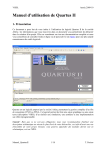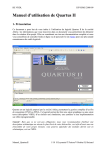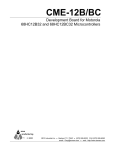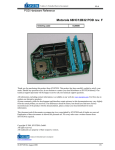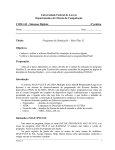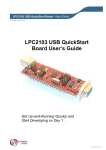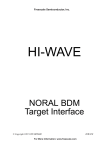Download UF 68HC12 Development Kit Manual
Transcript
UF 68HC12 Development Kit Manual (Version 4.01) EEL 4744: Microprocessor Applications October 2006 Page 1/24 Contents 1.0 Introduction................................................................................................................ 1 2.0 Installation & Quick Testing ....................................................................................... 1 3.0 Header Definitions..................................................................................................... 1 4.0 Jumper Definitions..................................................................................................... 3 5.0 Memory Map & Interrupt Vectors............................................................................... 5 6.0 CPLD/Header Cross Reference Table ...................................................................... 7 7.0 Schematics................................................................................................................ 8 A.1 68HC12B32 Pin-out ................................................................................................ 19 A.2 Altera 7064 – EPROM/EEPROM Decode Equations & CPLD Signal Pin-outs ....... 23 1.0 Introduction The UF 68HC12 Development Kit integrates the 68HC12B32 with an EPROM and an Altera 7064 CPLD. The purpose of the EPROM is to allow expanded mode booting of the 6812 using the UF-6812 Monitor/Debugger, D-Bug4744 (similar to Motorola’s D-Bug12). I/O can be easily connected to the processor via address decoding in the CPLD. These features, coupled with the fact that the 6812’s address, data, control and port pins are broken out to 100 mil headers, provide a fast and easy platform for prototyping of hardware with the 68HC12B32 Micro-controller. 2.0 Installation & Quick Testing 1. Connect a USB cable between the 6812 Development board and your PC. 2. Connect a 5V power supply to Header J11. Note: Pin1 is +5V and Pin3 is Ground. See Figure 1 for the location of Header J11. * Note: Alternatively, you may power your 6812HC12 board using the power supplied from your computer via the USB cable. To enable this, short solder across the jumper labeled RP. DO NOT CONNECT BOTH POWER SUPPLIES AT THE SAME TIME!* 3. Open a terminal application on your PC. Set your terminal properties to: Connect Using: Transfer Rate: Data Bits: Parity: Stop Bits: Flow Control: Communication Port Assigned to USB Port (e.g. Com1) 9600 bits per second 8 None 1 None 4. Press the Reset Button on the Board. 5. You should now see the monitor menu show up in your terminal. 6. If you do not see this menu in your terminal application, check all of your board’s jumper settings using the definitions in the next section. Note that the bubbles on the header pins on the schematics do not represent activation-level information. Headers are passive devices. UF 68HC12 Development Kit Manual (Version 4.01) EEL 4744: Microprocessor Applications October 2006 Page 2/24 3.0 Header Definitions This section provides a detailed description of the headers on the board as well as their functions. See Figure 1 for header location. (Note that the bubbles on the header pins on the schematics do not represent activation-level information. Headers are passive devices.) FIGURE 1. HEADER AND JUMPER DEFINITIONS J15 (+3.3V) - +3.3V Header where all pins are attached to the 3.3V regulator of the CP2103 IC chip. J14 (BDM) – J14 is the Background Debug Mode (BDM) header from the HC12. It is the standard BDM header as defined by Motorola. J2 (JTAG) – J2 is the JTAG header for the CPLD. This is the standard JTAG programming header. J10 (RX/TX) – J10 allows the user to access the RX and TX pins of the HC6812. J11 (5V) – J11 is the input for a regulated 5V power source. Note: To use this as a power input, make sure that jumper RP is not enabled. J18 (Port P) – J18 contains the 6812’s Port W pins. This port is also referred to as Port P in some Motorola documentation. See schematics for exact pin definitions. J4 (Port AD) – J4 contains the 6812’s analog-to-digital port, Port AD. Bits 1:0 must be grounded upon reset for D-Bug12 to run. See schematics for exact pin definitions. This is not yet implemented in D-Bug4744. When it is implemented, D-Bug4744 will use Port AD, bit 7. J22 (Port T) – J22 contains the 6812’s Port T. See schematics for exact pin definitions. J6 (Cntl Sigs) – J6 contains some commonly used bus control signals. The pin-out of this header is shown in Figure 2. (- denotes an active low signal) Note that the bubbles on the header pins on the schematics do not represent activation-level information. Headers are passive devices. UF 68HC12 Development Kit Manual October 2006 (Version 4.01) EEL 4744: Microprocessor Applications GND GND - IRQ DBE GND ECLK GND GND R/W -Reset Page 3/24 Figure 2. Header J6 Pin Definitions J17 (Latched Address) – J17 contains the 16 bit latched address output from the 74373’s. Note: In previous semesters, 374’s were used with ECLK tied to the CP input. 373’s however, eliminate the need for a delayed ECLK, but they require #ECLK for the latch enable. J30 (Data) – J30 contains the 8 bit data I/O pins from the 6812. This header is not buffered and is connected directly to the 6812, therefore it also contains the raw upper 8 bit address. J16 (CPLD I/O) – J16 contains all the CPLD I/O lines for general purpose use including CPLD special function input pins 1 (input/CLR), 2 (input/CLK2), 43 (input/CLK1), and 44 (input/OE1).. J31 (Port S) – J31 contains the 6812’s Port S. J32 (Port DLC) – J32 contains the 6812’s Port DLC. J25 A/B and J26 A/B (EPROM & EEPROM) – Jumpers are used to select between using EPROM or EEPROM in socket U1. These are implemented as the footprints of surface mount resitors. Connecting the pads with solder is the equivalent of installing a jumper. 4.0 Jumper Definitions This section provides a detailed description of the jumpers on the board as well as their functions. See Fig. 1. Jumpers are implemented as the footprints of surface mount resistors. To connect or disconnect a signal, simply drag a trace of solder across the pads or break said trace with a hot soldering iron. J1 (ROM OE) – J1 connects the ROM’s output enable signal (OE) to the CPLD via pin 26 on the CPLD. If this jumper is removed, the ROM’s OE signal is left floating. Default: Connected J25 A/B and J26 A/B (EPROM & EEPROM) – These jumpers are used to select between using EPROM or EEPROM in socket U1. For EPROM, J25 B and J26 B should be connected. For EEPROM, J25 A and J26 A should be connected. Default: EPROM Note that the bubbles on the header pins on the schematics do not represent activation-level information. Headers are passive devices. UF 68HC12 Development Kit Manual October 2006 (Version 4.01) EEL 4744: Microprocessor Applications Page 4/24 J20 (BKGD) – This jumper selects the Background Debug Mode. Note: If you install this jumper, you must remove it after reset. This must be done because BKGD is also as a communication line in the BDM header (J14). Default: Open (Vfp) – Flash Programming Jumper. If installed, connects +12V from Header J10 to VFP pin on 6812. Default: Open J3 (SA) – This header is used to enable standalone mode on the board. When this jumper is open, PLDC0 is high. When the jumper is connected, PLDC0 is pulled low. The Monitor program can be edited to poll this signal and begin a running pre-described code in memory. Default: Open J9 (MOD A) – J9 is the Mode A input to the HC12. Default: Connected J8 (MOD B) – J8 is the Mode B input to the HC12. Default: Open RP (PS) – This allows the user to select between which power input will be used. If an unregulated power source is used via header J10, RP must be disconnected. If you wish to power the board through the USB cable, RP should be connected. Default: Open Power Source J7 Reg 5V on J11 Unconnected USB Connected Figure 3. J7 Definition J5 (CPLD Jumpers) – J5 contains a variety of control signals to connect to the CPLD. Each signal is labeled on the board next to the pin it controls. When the jumpers are connected the signals are connected to the CPLD pins according to Figure 3. All the address signals come from the latched address source, thus, they are not the raw address signals. Typically, all the jumpers are installed except those on XIRQ and IRQ. Note: Students should determine which signals to connect for proper memory decoding of the EPROM/EEPROM in the memory map. All decoding circuitry is found in the CPLD. 6812 Signal CPLD Pin DBE 21 A12 20 A13 19 A14 18 A15 17 Reset 16 R/W 14 ECLK 12 XIRQ 11 IRQ 9 Figure 4. J5 Connections Note that the bubbles on the header pins on the schematics do not represent activation-level information. Headers are passive devices. UF 68HC12 Development Kit Manual October 2006 (Version 4.01) EEL 4744: Microprocessor Applications Page 5/24 5.0 Memory Map & Interrupt Vectors Single Chip Mode Address (Hex) 0-1FF 800-BFF D00-FFF 8000-FFFF Devices 6812 Internal Registers 1K Internal SRAM 768 Bytes of Internal EEPROM *32K Bytes Flash Memory (~100 Writes Only) Expanded Mode Address (Hex) 0-1FF 800-BFF D00-FFF 8000-FFFF *Note: Devices 6812 Internal Registers 1K Internal SRAM 768 Bytes of Internal EEPROM *External 32K space. We added an 8K EPROM from E000-FFFF. Lower 8K in Single Chip Mode is the same as the lower 8K in Expanded Mode. The upper 32K in Single Chip Mode is Flash Memory and in Expanded Mode this area is open for attaching new devices (which is why we chose to place EPROM here). Internal SRAM in both Single-Chip and Expanded Modes Address (Hex) 800-88F 890-8FF 900-BDF BE0-BFF Explanation Pseudo-vector locations and variables in Internal SRAM (approx.) Internal SRAM available to user with D-Bug4744 (I usually use this for my stack) Internal SRAM available to user with D-Bug4744 D-Bug4744 stack space CPLD ROM Decoder Logic Equation: ROM_OE = ~RESET * RW * ECLK * A15 *A14 *A13 Note that OE, RESET, and DBE are active-low and RW = R(H) = W(L) = R/~W . When you build the circuit to create this equation, remember that activation level mismatches create NOTs for free. The ROM will only send outputs to the data pins during read operations when DBE is true and the addresses are appropriate for the ROM (from $E000-$FFFF). Note that the bubbles on the header pins on the schematics do not represent activation-level information. Headers are passive devices. UF 68HC12 Development Kit Manual October 2006 (Version 4.01) EEL 4744: Microprocessor Applications Page 6/24 Interrupt Vectors (6812 Hard Designations) and Interrupt Pseudo-vectors Address (Hex) FF80-FFC1 FFC2-FFC9 FFCA, FFCB FFCC, FFCD FFCE, FFCF FFD0, FFD1 FFD2, FFD3 FFD4, FFD5 FFD6, FFD7 FFD8, FFD9 FFDA, FFDB FFDC, FFDD FFDE, FFDF FFE0, FFE1 FFE2, FFE3 FFE4, FFE5 FFE6, FFE7 FFE8, FFE9 FFEA, FFEB FFEC, FFED FFEE, FFEF FFF0, FFF1 FFF2, FFF3 FFF4, FFF5 FFF6, FFF7 FFF8, FFF9 FFFA, FFFB FFFC, FFFD FFFE, FFFF Devices Reserved for future use Reserved for mfg. test Pulse Accumulator B Overflow Modulus Down Counter Underflow Reserved for mfg. test BDLC Analog-to-Digital Reserved SCI #0 SPI Serial Transfer Complete Pulse Accumulator Input Edge Pulse Accumulator Overflow Timer Overflow Timer Channel #7 Timer Channel #6 Timer Channel #5 Timer Channel #4 Timer Channel #3 Timer Channel #2 Timer Channel #1 Timer Channel #0 Real Time Interrupt IRQ XIRQ SWI Reserved for the Future COP Failure Reset Clock Monitor Failure Reset *Reset Pseudo-Vector Address $0809-$080B $080C-$080E $080F-$0811 $0812-$0814 $0815-$0817 $0818-$081A $081B-$081D $081E-$0820 $0821-$0823 $0824-$0826 $0827-$0829 $082A-$082C $082D-$082F $0830-$0832 $0833-$0835 $0836-$0838 $0839-$083B *$FF6C $083F-$0841 $0842-$0844 $0845-$0847 *$FF80 Interrupt Pseudo-Vector Description Analog-to-Digital Serial Communications Interface (SCI) Serial Peripheral Interface (SPI) Pulse Accumulator Input Edge Pulse Accumulator Overflow Timer Overflow Timer Channel 7 Timer Channel 6 Timer Channel 5 Timer Channel 4 Timer Channel 3 Timer Channel 2 Timer Channel 1 Timer Channel 0 Real Time Interrupt (RTI) IRQ XIRQ Software Interrupt (SWI) Unimplemented Opcode Trap COP Failure Reset Clock Monitor Failure Reset Reset Table 2. 6812 interrupt pseudo-vectors. Table 1. 6812 interrupt vectors. Note: On the UF 68HC12 Development Kit, the addresses in FFFE & FFFF in external (added on) EPROM point to the external EPROM location of the D-Bug4744 (UF-6812 Monitor/Debugger) Thus at this location in EPROM there is a vector that is loaded into the PC that causes program flow to begin at the first location in EPROM. General Hints and Tips • When the 6812 is reset into any normal mode, the COP watchdog timer is automatically enabled. To disable it write $00 to the COPCTL register at address $0016. • When the 6812 is reset into any normal mode the R/W disabled externally and the pin is pulled high. To enable the R/W signal write $04 to the PEAR register at address $000A • The two items above are already performed in the D-Bug4744 (UF-6812 Monitor/Debugger) Note that the bubbles on the header pins on the schematics do not represent activation-level information. Headers are passive devices. UF 68HC12 Development Kit Manual (Version 4.01) EEL 4744: Microprocessor Applications October 2006 Page 7/24 6.0 CPLD/Header Cross Reference Table The following table should prove very useful when adding memory-mapped components to the board. It provides a quick reference between the CPLD pin numbers (as seen in Quartus or MaxPlusII) and the CPLD I/O header (J16) pin numbers that will be will be wire-wrapped to on the board. The hard-wired signals require the proper jumper be installed on the CPLD jumper header (J5). Quartus / MaxPlusII CPLD CPLD I/O Hard-wired Signal & Type I/O # Pin # Header Pin # (if any) relative to the CPLD 1 4 1 UART_TX_in 2 5 3 3 6 5 4 8 7 5 9 9 IRQ , Output 6 11 11 7 8 9 10 11 12 13 14 15 16 17 18 19 20 21 22 23 24 25 26 27 28 12 14 16 17 18 19 20 21 24 25 26 27 28 29 31 33 34 36 37 39 40 41 13 15 17 19 21 23 25 27 28 26 24 22 20 18 16 14 12 10 8 6 4 2 XIRQ , Output ECLK, Input R/ W , Input RESET , Input A15, Input A14, Input A13, Input A12, Input DBE , Input ECLK , Output Boot ROM Enable, Output UART_TX_Out Note: On the UF 68HC12 Development Kit version 4.0, ECLK is already routed to each of the 373’s latch enable (LE on pin 11). Note that the bubbles on the header pins on the schematics do not represent activation-level information. Headers are passive devices. UF 68HC12 Development Kit Manual October 2006 (Version 4.01) EEL 4744: Microprocessor Applications Page 8/24 J16 : CPLD IO Header Pin-out Note that the bubbles on the header pins on the schematics do not represent activation-level information. Headers are passive devices. UF 68HC12 Development Kit Manual (Version 4.01) EEL 4744: Microprocessor Applications October 2006 Page 9/24 7.0 Schematics Address Latches (74F373’s are actually used, not 74LS373’s). Pin 11 (marked C) is the latch enable (LE) Note that the bubbles on the header pins on the schematics do not represent activation-level information. Headers are passive devices. UF 68HC12 Development Kit Manual October 2006 (Version 4.01) EEL 4744: Microprocessor Applications Page 10/24 J15 : 3.3V Regulated output J6 : Control Signal Header Note that the bubbles on the header pins on the schematics do not represent activation-level information. Headers are passive devices. UF 68HC12 Development Kit Manual October 2006 (Version 4.01) EEL 4744: Microprocessor Applications Page 11/24 USB Bridge (CP2103) and USB Port (JP 23) Alternative access to TX and RX are found on J10 and PS0, PS1 CP2103 Information The CP2103 is a USB 2.0 to UART Bridge. It is has the capability of taking full-speed data (12Mbps) from a USB cable and converting this data to serial using the internal UART. The UART has an internal clock and the capability to provide baud rates up to 1 Mbits. The CP2103 also has an onboard voltage regulator providing a 3.3V output (J15) and 4 general purpose IO’s for status and control. The chip works with most operating systems including Windows®98 SE/2000/XP, MAC OS9, and MAC OS-X. The data sheet can be found at: http://www.silabs.com/public/documents/tpub_doc/dsheet/Microcontrollers/Interface/en/cp2103.pdf Note that the bubbles on the header pins on the schematics do not represent activation-level information. Headers are passive devices. UF 68HC12 Development Kit Manual October 2006 (Version 4.01) EEL 4744: Microprocessor Applications Page 12/24 CPLD Pin Layout Note that the bubbles on the header pins on the schematics do not represent activation-level information. Headers are passive devices. UF 68HC12 Development Kit Manual October 2006 (Version 4.01) EEL 4744: Microprocessor Applications Page 13/24 J30 : Data Bus Serial Port Circuit (DB9- Used in later labs) Alternative access to TX and RX are found on J10 and PS0, PS1 Note that the bubbles on the header pins on the schematics do not represent activation-level information. Headers are passive devices. UF 68HC12 Development Kit Manual October 2006 (Version 4.01) EEL 4744: Microprocessor Applications Page 14/24 EEPROM (28C64 or 28C256) or EPROM (27C256 or 27C64) Note that the bubbles on the header pins on the schematics do not represent activation-level information. Headers are passive devices. UF 68HC12 Development Kit Manual October 2006 (Version 4.01) EEL 4744: Microprocessor Applications Page 15/24 Note that the bubbles on the header pins on the schematics do not represent activation-level information. Headers are passive devices. UF 68HC12 Development Kit Manual October 2006 (Version 4.01) EEL 4744: Microprocessor Applications Page 16/24 J18 : Port P J31 : Port S Note that the bubbles on the header pins on the schematics do not represent activation-level information. Headers are passive devices. UF 68HC12 Development Kit Manual October 2006 (Version 4.01) EEL 4744: Microprocessor Applications Page 17/24 J22 : Port T Note that the bubbles on the header pins on the schematics do not represent activation-level information. Headers are passive devices. UF 68HC12 Development Kit Manual October 2006 (Version 4.01) EEL 4744: Microprocessor Applications Page 18/24 J17 : Address Bus Note that the bubbles on the header pins on the schematics do not represent activation-level information. Headers are passive devices. UF 68HC12 Development Kit Manual October 2006 (Version 4.01) EEL 4744: Microprocessor Applications Page 19/24 Reset Circuitry Stand-Alone Jumper and Background Jumper Note that the bubbles on the header pins on the schematics do not represent activation-level information. Headers are passive devices. UF 68HC12 Development Kit Manual October 2006 (Version 4.01) EEL 4744: Microprocessor Applications Page 20/24 U4 : 68HC12B32 Pin-out Note that the bubbles on the header pins on the schematics do not represent activation-level information. Headers are passive devices. UF 68HC12 Development Kit Manual October 2006 (Version 4.01) EEL 4744: Microprocessor Applications Page 21/24 The following figures are magnified sections of the 68HC12 schematic: To Port S Header To Port T, S, AD Note that the bubbles on the header pins on the schematics do not represent activation-level information. Headers are passive devices. UF 68HC12 Development Kit Manual October 2006 (Version 4.01) EEL 4744: Microprocessor Applications Page 22/24 Port E Pins Shared Address and Data Bus Note that the bubbles on the header pins on the schematics do not represent activation-level information. Headers are passive devices. UF 68HC12 Development Kit Manual October 2006 (Version 4.01) EEL 4744: Microprocessor Applications Page 23/24 Note that the bubbles on the header pins on the schematics do not represent activation-level information. Headers are passive devices. UF 68HC12 Development Kit Manual (Version 4.01) EEL 4744: Microprocessor Applications October 2006 Page 24/24 A.2 Altera 7064 – EPROM/EEPROM Decode Equations & CPLD Signal Pinouts Required EPROM/EEPROM Equations for 8k device at $E000-$FFFF: ROM_CE = RESET * RW * ECLK * A15 * A14 *A13 ECLK = ECLK UART_TX_in = UART_TX_out Note that CE, RESET, and DBE are active-low. Pin Name & Activation Level ROM_CE(L) RESET RW [=R/ W =R(H)=W(L)] DBE A15(H) A14(H) A13(H) ECLK ECLK UART_TX_in UART_TX_out CPLD Pin # 26 16 14 21 17 18 19 12 24 4 41 The above equation and pin-outs enable the EPROM/EEPROM from $E000 to $FFFF in the 6812’s memory map. This information can be programmed into the CPLD either as a circuit (BDF/GDF file) or as VHDL code (with filename extension .vhd) using the Quartus/MaxPlusII software. A student version of Quartus/MaxPlusII is available (for free) at http://www.altera.com. Programming Note (using Byte Blaster cable and JTAG header on board): When programming the CPLD, remove all of the jumpers between the processor and the CPLD so that signals from the processor can't interfere in the programming process. These jumpers can be found on the header labeled “CPLD Jumpers” on the development board. Note that the bubbles on the header pins on the schematics do not represent activation-level information. Headers are passive devices.

























